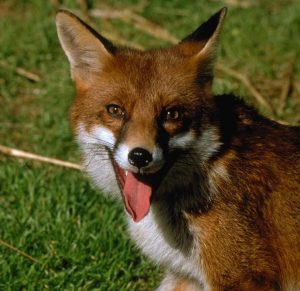
More fox research is needed.
YOUNG foxes have lived on sheep meat and native animals in Western Australia’s wheatbelt outside of normal lambing times, Murdoch University research has found.
Scientists from Murdoch University studied the jaw strength and gut contents of 540 foxes captured through a community-based feral animal control program in the state’s wheatbelt in 2010.
The foxes were collected from 13 different locations in WA’s ‘sheepbelt’ from Gingin to Corrigin to Mount Barker through the Red Card for Rabbits and Foxes program in summer and autumn of 2010. There is some early lambing in in the area from March to May, but most occurs from June to August.

Associate Professor Trish Fleming at Murdoch University WA.
Murdoch University’s Associate Professor Trish Fleming has just published the findings of research that involved the analysis of hundreds of fox carcasses and their stomach contents to find out more about what the predator eats.
“We’ve found that juvenile foxes eat as much sheep as an adult fox, with sheep making up to two-thirds of their stomach contents,” said Professor Fleming.
“We also found foxes feast on brushtail possums, reptiles, frogs, birds and invertebrates.”
Click here to get the latest Sheep Central story links sent to your email inbox.
Of the 540 foxes analysed, 401 had sheep material in their stomachs and maggots were recorded from 28 or about 7 percent. This indicated that about 93pc of the foxes could either have been feeding on dead sheep or were attacking live animals as their major food source, although more research is needed to confirm this.
Most of the sheep material recovered from the fox stomachs was believed to be carrion – meat, skin, wool or bones, with or without maggots. This indicated that leaving carcasses of dead sheep in paddocks might subsidise a fox’s diet, especially during the summer/autumn juvenile dispersal period in Western Australia. Some rubber tail rings were also found.
Accepted lamb mortality research has shown that the major causes of lamb deaths in Australia include dystocia or difficult birth, low lamb birth weight, starvation and mismothering, with predators playing a minor role in the losses of healthy lambs. But farmers told the WA researchers that foxes killed lambs and attacked ewes while they were lambing.
The Murdoch University scientists said the introduced red fox species posed a serious conservation and pest problem in Australia. Foxes can cause economic losses by also preying on free-range poultry, and occasionally on young lambs and kid goats. There is strong evidence to suggest that foxes have caused the decline of many small to medium-sized species of Australian native mammals, the university said.
The research indicated that dead sheep and lambs not properly disposed of could help sustain a baseline fox population that then becomes a risk to sheep flocks and native animal and bird populations.
Need for more research
Associate Professor Fleming said further research was needed.
“The issue of fox predation receives very little research funding despite the potential impact.
“Just for example, if farmers are only recording an 80 percent weaning rate, then they are still losing about 40-50pc of their lambs,” she said.
“We need to quantify the actual numbers to ensure that we can make a solid case for adequate predator control.
“I would like to propose a program of collecting data on weaning rates for comparison with current and past predator control, carried out across a wide landscape,” Assoc. Prof. Fleming said.
“Talking to farmers, capturing their records and impressions around foxes on their land, tracking where foxes go, will provide insight into how we can better manage their impacts.”
Predator control can have an immediate benefit
Associate Professor Fleming said, by contrast, the investment in breeding genetics — where there may be an increase in small percentage value for individual carcases or wool over a number of generations — does not have the same immediate and large benefit that control of predators can yield.
“Where they cannot control them, predators are sufficient to have completely driven many farmers away from small stock production.”
Professor Fleming said by studying skull morphology, bite force and teeth, they found 57pc of the foxes culled were less than one year old.
“This is probably because they were young, naïve and on the move away from their home, so more likely to be shot,” she said.
“This information reinforces the need for coordinated pest animal control to boost the productivity of livestock farmers and protect native animals.
“The female foxes tended to feed on rodents and invertebrates.
“This may suggest they stay closer to sheds and houses.”
The Murdoch University scientists said the introduced red fox species posed a serious conservation and pest problem in Australia. Foxes can cause economic losses by also preying on free-range poultry, free-range piglets, and occasionally on young lambs and kid goats. There is strong evidence to suggest that foxes have caused the decline of many small to medium-sized species of Australian native mammals, the university said.
Need for fox co-ordinator funding
Associate Professor Fleming said there is also very little funding invested into co-ordinating fox culls. The position of co-ordinator for the Red Card programme has not been funded through a permanent government departmental position, and the program has relied on applying for NRM funding, which is ad hoc and short-term.
More than 800 people from Northampton through to Esperance participated in this year’s Autumn Red Card for Rabbits and Foxes shoot, organised by the Sporting Shooter’s Association of WA.
Natural resource management group Wheatbelt NRM receives funding through the Western Australian Government’s State NRM Program to co-ordinate the Red Card program
The group’s Jacquie Lucas said the autumn shoot removed nearly 2500 foxes, 150 feral cats and almost 590 rabbits from the environment.
Source: Murdoch University.

HAVE YOUR SAY